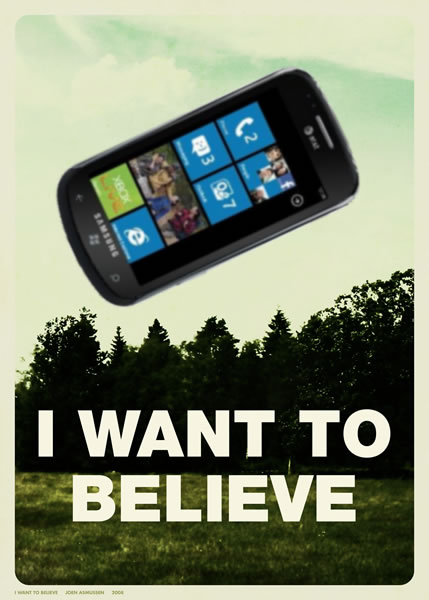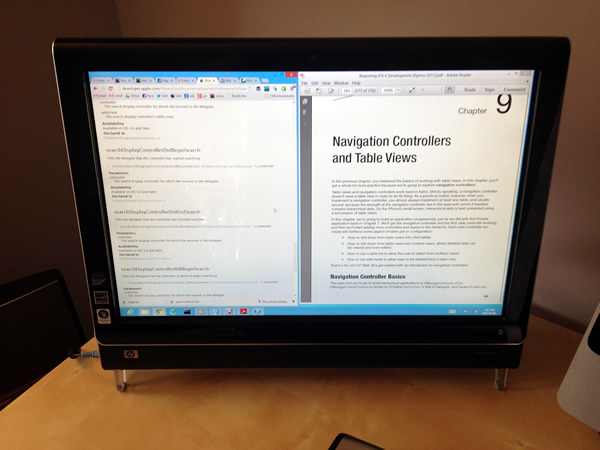
Found via Matt McDougall.

Found via Matt McDougall.
For some people, there’s no thing as having too much hardware. I know a few guitar players who’d salivate at the chance to get their mitts on this beast:
12-necked guitar created by Yoshihiko Satoh.
Click the photo to see the full story.
It may be the same case if you’re a SharePoint developer. Here’s an excerpt from an article written by Sahil Malik titled Upped My Main Dev Machine, where a developer talks about what he did to speed up some painfully long build times (with some formatting and emphasis added by me):
Last Friday, I was busy compiling a big project in my consulting life. I realized, it takes a good 5-10 minutes for the project to compile and deploy.
On my main desktop, I was pimping 24G of RAM and a Core i7 930 processor.
The problem wasn’t those 5-10 minutes, the problem was, I got distracted, started watching funny dog videos on youtube, and well – lost time, lost track of what I was doing. Quite unproductive.
…
So, I got in my car, drove to a local hardware store, and bought new computer parts. 3 hours later, I have my new rig running.
I now have a gigabyte x79 up4 motherboard, Corei7 3930K processor, and 64G of RAM.
I can understand needing that kind of setup for computationally intensive work — weather simulations, AI, protein folding, controlling the flight of SpaceX ships — but for compiling Sharepoint applications? We’re not talking about multidimensional matrix math, Fourier transforms, or Watson-style artificial reasoning, but building the sort of applications that SharePoint was meant to host: web applications and sites, document sharing, blogs and forums, and list management.
Requiring such big iron to build relatively mundane applications is like requiring all the architecture, engineering and construction teams behind the Burj Khalifa in Dubai to renovate your kitchen.

It shouldn’t be surprising that many people have started looking for alternatives:
Click the photo to see it at full size.

Since I was once a Microsoft developer evangelist specializing in Windows Phone and a designated Windows Phone Champ, I’m occasionally asked why I don’t do Windows Phone development anymore.
One of the reasons is quite simple: I can’t. I’d need new hardware. Even more so than SharePoint developer Sahil Malik. At worst, he has to wait ten minutes for each build. I can’t even do that.
Here’s my best Windows machine at the moment: a late 2008-era Dell Latitude E6500 with 8 gigs of RAM, with a Core 2 Duo P8700 running at 2.5 GHz. It’s hardly top-of-the-line, but when it was used as a developer demo machine at Microsoft, it had no problem building Windows desktop apps, web applications with ASP.NET MVC or Windows Phone 7 apps. Later, after it was given to me as a fabulous parting gift, it proved to be a fine machine for building PHP, Rails and CoffeeScript apps under both Windows and Ubuntu. Even though it’s not my main development machine, it still performs yeoman service at my home office.

My other Windows machine is my living room entertainment/casual hacking box, a 2009-era HP IQ526 TouchSmart touchscreen all-in-one with 4 gigs of RAM, powered by a Core 2 Duo T6600 processor. I used a similar machine at Microsoft to demo Windows Phone 7 app and Android app development.

Both of these machines are powered by processors that don’t support SLAT — Second Level Address Translation. The current version of Windows’ Hyper-V virtual machine, on which the Windows Phone 8 emulator runs, requires SLAT. i3, i5 and i7 processors have SLAT, but not the older Core 2s. My Windows machines may not be new, but they do a fine job running 64-bit Windows 8, the current edition of Microsoft Office, Adobe CS6 applications and more. Oddly enough, I can develop Windows 8 desktop and tablet apps with them; I can even develop Android and BlackBerry apps. I just can’t use them to develop Windows Phone apps. And I’m not the only one in this boat.
Beside my HP Touchsmart is this 20″ iMac that’s even older — it’s from mid-2007 and sports a Core 2 Duo T7300 processor. I’ve maxed out its RAM beyond the advertised 4 gigs; it turns out that you can take it up to 6:

This machine came out almost six years ago. That’s around the same time as the original iPhone and three years before the iPad. In spite of its “age”, it runs the current version of MacOS (10.8, a.k.a. “Mountain Lion”) as well as Xcode and JetBrains’ AppCode — simultaneously (that’s AppCode 2 you’re seeing on the screen right now). Along with being a fine Rails, Django, and all-those-crazy-JS-frameworks dev machine, it does a fine job of building iOS apps for present-day devices, whether via Xcode, Xcode + AppCode, Appcelerator Titanium, RubyMotion or what-have-you. It’s also a nice Android development machine.

If my hardware problem wasn’t a big enough barrier, there’s also Windows Phone’s standing in the market. Here’s a chart that was published yesterday in a Splat F article, Microsoft’s Mobile Comeback Isn’t Happening:
Click the graph to see it at full size.
In spite of the fact that Windows Phone is outselling the iPhone in Elbonia, there just isn’t enough demand, either in terms of quantity or quality. Windows RT’s prospects are even worse.
I’ve decided that the best mobile development self-education approach for me is: teach myself iOS development first, Android development eventually, perhaps Appcelerator, and barring any dramatic changes in circumstance, don’t bother with anything else. I’d love to learn how to develop for all the mobile platforms, but I just haven’t got the time.
Update: I added the graph from Splat F, which David Janes pointed me to. Thanks, David!

Sometimes, when I read stuff on the web, it makes me want to do this.
I’ve seen technology make some great leaps over the past three decades. As for some technologists, they’ve remained stuck in the stone age.

Here’s the start of game developer Andy Moore’s most recent blog post:
Last night was the end of an amazing GDC trip. A handful of remaining friends and I made a journey out to JapanTown and we had an amazing meal. It was a great way to end the trip.
One of my friends, and a fellow game developer, was there for dinner. Her trip to GDC was planned last-minute, thanks to someone obtaining her a (very expensive!) all-access pass.
When recounting this chain of events, a male game developer at the table said that she only got the GDC pass “because of her tits.”
The table largely responded with aghast looks and silence. It was brought up that perhaps her ticket was thanks to being an award-winning game developer.
The same male responded with the ever-classy “sure, award winning tits.”
Ah, the “fake geek girl” accusation, just in slightly different form. As this Atlantic article puts it, it’s not really about female duplicity, but male insecurity.
For even more jack-assery, read the post and check out the comments. Zoe, the female game developer who got the pass and was the target of the dickish remark, tells the story from her perspective, and another game developer named Phil — who at least in the beginning seems to have good intentions — effectively tells her to “man up”.
And we wonder why the industry is such a god-damned sausage party.
Andy Moore’s story would fit very well in the tumblr of similar stories called Programmers Being Dicks. It’s been around for just over a year, and you get three guesses as to what it’s all about.

Shoreditch Works has a great collection of advice on how to navigate the male-skewed tech industry and tech conferences, and even some good advice for guys from Aanand Prasad, which I’ll repeat below:
No-one is without privilege, but as a man, you’ve been dealt a truckload. It’s difficult to acknowledge it without feeling ashamed or defensive, which is probably where that ridiculous idea of the “man-hating feminist” comes from. Just remember:
1. Your privilege isn’t something to be ashamed of– it’s something to be aware of. Being a man doesn’t make you a bad person – not giving a shit about it makes you a bad person.
2. Your privilege isn’t going to go away just because you’re aware of it: It’s always going to be there, clouding your perceptions and simplifying the world for you. Remain vigilant!
3. There are some things you should simply never do: Never tell a member of an oppressed group they’re not oppressed – you’ll do more harm than good, without fail.
4. Be careful not to hijack discussions: Men are taught to speak with authority even when they have none, even when others are more qualified to speak. Conversely, oppressed groups are taught to doubt their authority. Shut up and listen.
5. If you have any doubt in your mind as to whether to make a joke: don’t. You have nothing to gain. If you genuinely believe you can’t be funny without alienating people, you’re a desperately unimaginative person.

The topic of privilege — especially male privilege — often brings up indignation or eye-rolling from guys who’d otherwise seem to be upstanding people. The problem is that privilege is one of those things that you don’t notice when you’ve got it, even though it seems like it would be obvious if you did (“How can I be privileged? The mayor’s never given me the key to the city!”). Blogger Doug Muder does a great job of summarizing this feeling in The Distress of the Privileged. He uses a scene from the movie Pleasantville to make his point, hence the WIlliam H. Macy screencaps above.

Another worthwhile read is the last item in Cracked’s article, 5 Ways You’re Accidentally Making Everyone Hate You. All five ways, it turns out, end up being variations on the theme of power dynamics between people. The relevant item’s titled “But I Was Okay With It!”, and here are the key excerpts:
This will happen to you. You will be on one side of a conflict that does not feel like a conflict to you, because that is the conflict. Trust me, there’s a great chance you’ll be oblivious to it until it’s too late. Entire governments have fallen this way.
In many cases, they mean it honestly – “I’m not angry at anyone, I just want to leave things the way they are.Which incidentally involves me having all of the power.”

And finally, here’s the full text of an entry I made earlier in my personal blog, The Adventures of Accordion Guy in the 21st Century…
It’s been over twenty years since Neal Stephenson’s “cyberpunk” novel Snow Crash was first published. A young Cory Doctorow, then working at the sci-fi bookstore Bakka Books, saw me in my engineering jacket from Crazy Go Nuts University and convinced me to buy it.
As is the tradition with the best science fiction, Snow Crash is is densely packed with all sorts of interesting ideas about present-day society, somewhat disguised in the wrappings of what was then the near future. Stephenson has a gift for illustrating them, and a number stand out in my mind even years later, such as how children’s pajamas of that near future could either be fireproof or non-carcinogenic (but not both!), or how every guy under 25 secretly believes that under the right circumstances, he could’ve been the biggest badass in the world.
I first read the book in late 1992, soon after it was published. It had been only a couple of years since the killing of fourteen women at Montreal’s École Polytechnique, a couple of months since Anita Hill’s testimony at Clarence Thomas’ confirmation hearings, and Naomi Wolf’s The Beauty Myth and Susan Faludi’s Backlash: The Undeclared War Against American Women were often-discussed topics on my university’s campus. All this, along with my own sense of social justice, is likely why of all the interesting ideas that Stephenson put into Snow Crash, the one that stands out most for me was how men in tech viewed women in tech.
Here’s the excerpt, with some added formatting. Given what’s going on in the world of tech today (including the surprised reactions at the discovery that the person who runs the wildly popular I Fucking Love Science Facebook page is a woman), it’s still spot-on:
Her name is Juanita Marquez.
Hiro has known her ever since they were freshmen together at Berkeley, and they were in the same lab section in a freshman physics class. The first time he saw her, he formed an impression that did not change for many years: She was a dour, bookish, geeky type who dressed like she was interviewing for a job as an accountant at a funeral parlor. At the same time, she had a flamethrower tongue that she would turn on people at the oddest times, usually in some grandiose, earth-scorching retaliation for a slight or breach of etiquette that none of the other freshmen had even perceived.
It wasn’t until a number of years later, when they both wound up working at Black Sun Systems, Inc., that he put the other half of the equation together. At the time, both of them were working on avatars. He was working on bodies, she was working on faces.
She was the face department, because nobody thought that faces were all that important — they were just flesh-toned busts on top of the avatars. She was just in the process of proving them all desperately wrong. But at this phase, the all-male society of bit-heads that made up the power structure of Black Sun Systems said that the face problem was trivial and superficial.
It was, of course, nothing more than sexism,the especially virulent type espoused bymale techies who sincerely believe that they are too smart to be sexists.

Zapp Brannigan, the personification of Mosolotshane’s attitude.
In the comments, a socially developmentally-delayed reader named “Mosolotshane” replied:
Apparently, women are sensitive, delicate creatures who must be shielded from coarse language lest they abandon their dreams of becoming a software developer and seek the shelter of being a stay-at-home-mom.
Before I could reply, one of the other grown-ups, Reg Braithwaite, responded with a great essay, I am Obviously Pissed, on his site. You should read the whole thing, but here’s the meat of his response:
In the 1950s, men did whatever they wanted and women had to put up with it. They also lived according to a strict set of rules about propriety that involved wearing a suit to work, cutting their hair, and so on. And no, they couldn’t say whatever they liked. here were very strict rules about what kind of language was appropriate and what wasn’t, where you could use a word like “whore” and where you couldn’t.
Despite claims to the contrary, if you wore a tie to work you were not expected to make jokes about penises on the job. That was a blue-collar thing to do. Sexy pinups were acceptable at work, if you also wore a hard hat and/or got grease on any part of your clothing.
Now it’s 2013, and you and your kind are trying to have it both ways, you greedy fucks. You want to insult and belittle people just like they did in the 1950s, but you also want to be free to wear whatever you want and say whatever you want in the workplace and/or at conferences where people are working.
There is no free lunch, and I am here to be the adult in your stinking playpen and tell you that. Now, either you invent a time machine and go back to that halcyon time where everyone feared atomic death from the skies, or you embrace the fact that times have changed.
Well put, Reg. I salute you with a filet mignon on a flaming sword!
Thanks to my friend Peach Flambee for the Zapp Brannigan reference!
Here are the figures from the infographic:
Creative Commons photo by Ed Sweeney. Click to see the original.
The New York Post (yeah, not the best of papers, but they’re quoting Cisco’s BYOD Insights 2013 report) posted a quick report on New Yorkers’ use of mobile phones for work, which includes these figures:
Creative Commons photo by Miguel Pires da Rosa. Click to see the original.
Other findings from Cisco’s BYOD survey:
Cisco’s report, BYOD Insights 2013, which you can download for free, concludes with this final thought:
The number of Americans with smartphones is steadily increasing. Adults who reported owning a device they classified as a smartphone jumped 12 percent in 2012 according to the Pew Center. As that number grows and more Americans return to the workforce in the recovery from this Recession, BYOD will cause security breakdowns and cost companies money.
Knowing some of your employees’ smartphone habits can help you prepare to mitigate the impact of those events.
Creative Commons photo by Nick Carter. Click to see the original.
Dell’s Executive Director of End User Computing, Margaret Franco, reports that half of their customers whose BYOD policies allowed users to bring in any mobile device they want to work experienced a security breach. That’s hardly a surprise; at my consultancy, I recommend specifying a set of supported BYOD platforms and devices and matching them with the appropriate apps, utilities and practices. You can’t go “anything goes” with BYOD; that’s just asking to give your IT department — if not the whole company — a big bag of hurt.

A popular implement for a common type of quarterbacking.
In the wake of the PyCon 2013 “Dongle” incident and the ensuing fallout, the emails — but notably, no tweets, Facebook comments or any sort of messages delivered in the open — have been trickling in, asking what my thoughts on the matter were, given that:
My answer: wait.

With the intersection of a lot of “hot button” issues: privacy, privilege, sexism, racism, back-and-forth accusations of misogyny and misandry and conflicting visions of justice, there’s been far too much bile being passed back and forth for listening and civil discourse to take place.
(If you really must read something on the topic, Amanda Blum’s take on it in her blog most closely aligns with my own point of view.)
I’d like my contribution to the discussion to be one that benefits rather than harms, and you can’t do that by “shooting from the hip”. That will take time and thought, care and consideration.

In the meantime, since the incident has caused more than a few people to ask “What is a developer evangelist, anyway?” Here are some links you may find useful:
…and here’s an article about how well I evangelized evangelism.
This article also appears in The Adventures of Accordion Guy in the 21st Century.

Found via Catsmob.com
Given the trend towards skinny notebooks like the MacBook Air and lookalike “ultrabooks” as our main axes, many of us have to work with a measly one or two USB ports. The colour-coding’s also helpful. I’d love to see more stacking USB cables like this.